Panel show: Dariel Studio redesigns Wieden+Kennedy’s Shanghai office
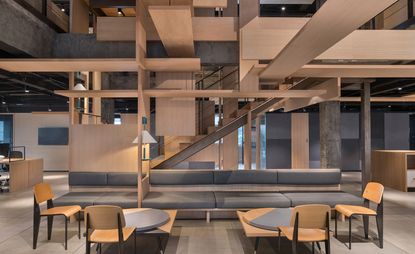
For the redesign of Wieden+Kennedy’s Shanghai office, Dariel Studio stripped back the existing office space revealing the raw structural materials, then added new functionality and a sculptural framework to unify and inspire the space.
At the core of the office, the symbol of the tree was used as a stylistic and conceptual design reference, reflecting the creativity and growth of the advertising agency – founded in 1982, Wieden+Kennedy now has eight international offices and a client base that includes major brands such as Nike, Heineken and Tiffany & Co.

An open plan work space is central to the office design
Over the existing central staircase of the three-storey office, Dariel Studio used overlapping split joint boards, criss-crossed horizontally and vertically to achieve a three-dimensional cubist formation, abstractly resembling the trunk and branches of a tree. This visual component of the office makes use of the open stairway to further unify the spaces across storeys, creating a compelling focal point.
Thomas Dariel, principal designer and founder of Dariel Studio, worked closely with Yang Yeo, creative director of Wieden+Kennedy, to reflect the working values and practices of the studio through the office design. Communicating directly with clients and visitors, a white logo mounted on black powder-coated steel plate is positioned at the entrance, which is located in a courtyard, while inside at the reception wooden panelling is warm and welcoming.
On the second floor, an open plan working space is central to the collaborative and creative working methods of the company. Either side, thoroughfares are raised slightly to separate foot traffic from the space. Communal spaces such as the pantry and the gym have panoptic windows which bright floods of natural light into the space, as well as wood and brick interior surfaces. Materiality and geometric patterning run through the office design and out on the the rooftop terrace where a marble semi-circular bar counter is lit up with LED lighting by night.
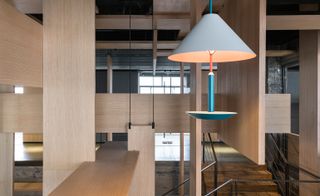
Interior design company Dariel Studio is based in Paris and Shanghai, and bring a blend of heritage and innovation to its designs across hospitality, commercial and residential projects
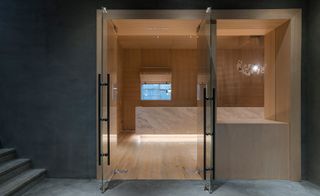
The entrance to the office is located inside a courtyard
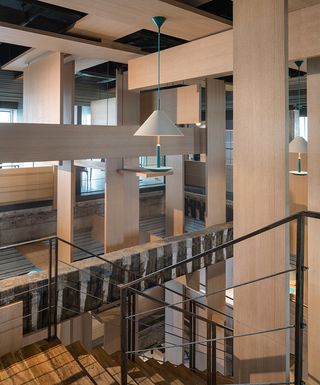
Over the existing central staircase, Dariel Studio used overlapping split joint boards to achieve a three-dimensional cubist formation
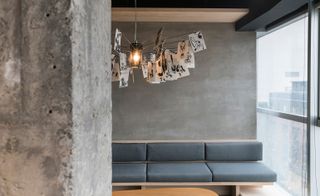
The original structure of the building has been stripped back to reveal raw concrete
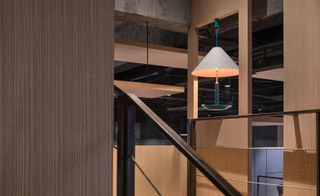
The sculptural design is an abstract focal point for the office
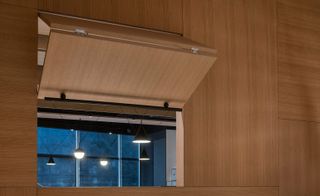
Custom made wooden shelving and panels are flexible to the office requirements
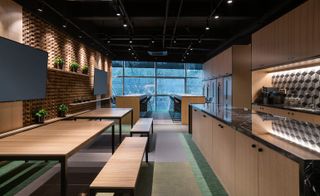
The ’pantry’ is kitted out with long tables and access to natural light
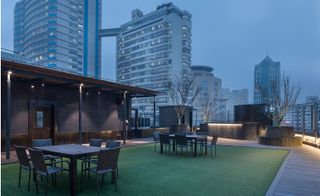
A rooftop space is also available for employees to use
INFORMATION
For more information, visit the Dariel Studio website
Wallpaper* Newsletter
Receive our daily digest of inspiration, escapism and design stories from around the world direct to your inbox
Harriet Thorpe is a writer, journalist and editor covering architecture, design and culture, with particular interest in sustainability, 20th-century architecture and community. After studying History of Art at the School of Oriental and African Studies (SOAS) and Journalism at City University in London, she developed her interest in architecture working at Wallpaper* magazine and today contributes to Wallpaper*, The World of Interiors and Icon magazine, amongst other titles. She is author of The Sustainable City (2022, Hoxton Mini Press), a book about sustainable architecture in London, and the Modern Cambridge Map (2023, Blue Crow Media), a map of 20th-century architecture in Cambridge, the city where she grew up.
-
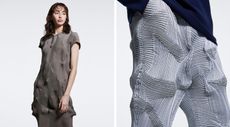 Get to know Issey Miyake’s innovative A-POC ABLE line as it arrives in the UK
Get to know Issey Miyake’s innovative A-POC ABLE line as it arrives in the UKAs A-POC ABLE Issey Miyake launches in London this week, designer Yoshiyuki Miyamae gives Wallpaper* the lowdown on the experimental Issey Miyake offshoot
By Jack Moss Published
-
 Eurovision unveils its 2024 stage, designed by Beyoncé's Renaissance Tour creatives
Eurovision unveils its 2024 stage, designed by Beyoncé's Renaissance Tour creativesThis year's stage design aims to bring the audience into the performance more than ever before.
By Charlotte Gunn Published
-
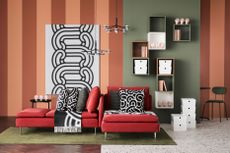 Ikea meets Japan in this new pattern-filled collection
Ikea meets Japan in this new pattern-filled collectionNew Ikea Sötrönn collection by Japanese artist Hiroko Takahashi brings Japan and Scandinavia together in a pattern-filled, joyful range for the home
By Rosa Bertoli Published
-
 Beijing City Library is an otherworldly escape from the digital world
Beijing City Library is an otherworldly escape from the digital worldBeijing City Library by Snøhetta is a flowing, welcoming space to share knowledge and socialise
By Tianna Williams Published
-
 Chinese scholar Zhang Taiyan’s house opens as a museum and bookshop in Suzhou
Chinese scholar Zhang Taiyan’s house opens as a museum and bookshop in Suzhou20th-century Chinese scholar Zhang Taiyan’s house in Suzhou has opened to the public as a museum, featuring a bookshop designed by Tsing-Tien Making
By Ellie Stathaki Published
-
 Jiaxing’s sunken train station is a hub of urban greenspace and efficient city links
Jiaxing’s sunken train station is a hub of urban greenspace and efficient city linksJiaxing Train Station by MAD Architects is a bubble of urban green space with a blend of reconstructed historical design and modern minimalism
By Tianna Williams Published
-
 Junya Ishigami’s Zaishui Art Museum in China was conceived as a ‘gentle giant’
Junya Ishigami’s Zaishui Art Museum in China was conceived as a ‘gentle giant’Japanese architect Junya Ishigami completes Zaishui Art Museum, a kilometre-long building positioned in a manmade lake and aiming to ‘bring the outside landscape in’
By Joanna Kawecki Published
-
 Sun Tower, rising on Yantai’s waterfront, wins Best Building Site in the Wallpaper* Design Awards 2024
Sun Tower, rising on Yantai’s waterfront, wins Best Building Site in the Wallpaper* Design Awards 2024We take a tour of the building site at Sun Tower, Open Architecture's new nature-inspired cultural attraction for the seaside town of Yantai in China
By Ellie Stathaki Published
-
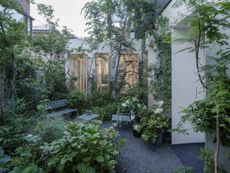 Forest Villa transforms an existing building shell into a minimalist villa engulfed in nature
Forest Villa transforms an existing building shell into a minimalist villa engulfed in natureForest Villa by HAS is a minimalist home in suburban China, crafted in an existing building shell, and working with its idyllic natural context
By Ellie Stathaki Published
-
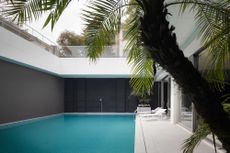 A Chinese island house brings luxury minimalism to seaside living
A Chinese island house brings luxury minimalism to seaside livingL House by AD Architecture is a Chinese island house that bridges luxury minimalism and seaside living
By Ellie Stathaki Published
-
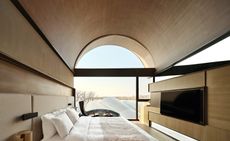 The Boatyard Hotel in Suzhou embraces the surrounding landscape
The Boatyard Hotel in Suzhou embraces the surrounding landscapeGOA and WJ Studio’s Boatyard Hotel in China takes its design cues from the nearby river
By Hannah Silver Published